first step
4C survey, data and data preparation
①Shop historical data, company resources and capabilities analysis
② Analysis of market capacity and growth rate of industry and category
③Growth of competitors or benchmark brands
④ Customer portraits, needs and preferences, consumption upgrade trends
Step 2
Clarify company strategy
1. Clarify the company's strategic positioning
2. Sorting out the three levels of company strategy
3. For companies with mature business, determine the second growth curve
4. Determine financial goals for the next three years
5. Determine the company's annual strategic theme...
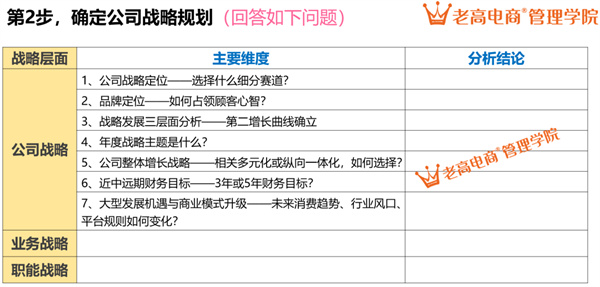
Case: A company's flagship store and specialty store have a total sales of 150 million yuan, and the market capacity of its segmented track is 1 billion yuan. According to the industry development laws, for sub-categories with a market share of less than 2 billion, if the market share accounts for 15%, it will be close to the ceiling. Multiple stores have a maximum share of 30%, and it is rare to exceed 30%. Therefore, the company has reached the ceiling and needs to design a second growth curve.
Step 3
Determine the business growth matrix and direction
1. Market penetration—the growth strategy of old products to old markets
2. Market development—the growth strategy of old products to new markets
3. Product Development—Growth Strategy of New Products to Old Markets
4. Diversification - the growth strategy of new products to new markets
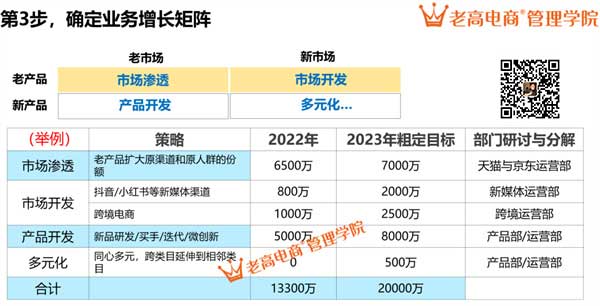
Case: (as shown in the picture above) Here is a review of the company's business growth points next year from the perspective of the combination of business and market. Among them, market development, new product development and diversification are all opportunities for innovative development. In-depth research and exploration will often lead to surprises.
Step 4
Clarify the store echelon and determine the target in a hierarchical manner
1. Two forms of target:
①From the top down - For startups, the boss sets goals.
②From the bottom up - targeting mature companies, set goals for teams and review by bosses.
Principle 1: If the team retreats, the company's goals should be set higher, which will give everyone a boost and pressure.
Principle 2: If the team moves forward, the company's goals should be lowered to make the team feel more accomplished.

2. Methods to set goals:
First camp: the fast-growing top shop
Method 1: Set the target according to 2-3 times the growth rate of the sub-category;
Method 2: Refer to and be above the main competitors.
Case: Suppose a growth rate of 10% in a certain home subcategory and a major competitor grows by 25%, then the target can be set to be more than 30%.
Method 3: Depend on the company's strategic plan for the next three years.
Case: A company's strategic goal for the next three years is 1 billion, that is, 1 billion in 2025, 800 million in 2024, and 500 million in 2023. Therefore, in 2023, the reverse method will be adopted and decomposed into various channels and stores according to the goal of 500 million.
Second camp: fast-growing waist shop
Method 1: If the store is in a rapid rise period, the goal is to reach the 6th and 7th levels;
Method 2: If you are in a slow climbing period, set the target according to the growth rate of 1-2 times in the sub-category;
Method 3: Depend on the company’s three-year strategic deployment.
Third camp: New store/leg store
Method 1: During the 3-6-month incubation period, you can vary the indicators, the key is the running mode and data. Performance appraisal focuses on process indicators.
Method 2: Entering the growth period, you can set the indicators for the next month last month. Set goals in the next quarter and gradually transition until annual goals are set.
Fourth camp: Sunset category stores that are stagnant or falling
The focus of this type of store is to maintain the status quo. Never make too much investment, no matter how much investment is, it will be futile.
Step 5
Jockey race passes, goal breakdown
1. Convene a goal seminar, and all operation store managers will attend.
2. Discuss the annual and monthly target settings of each store one by one.
3. Let the most ambitious store manager pass the meeting first, lead the morale and create an atmosphere of chasing each other.
4. The higher the goal, the better the promotion fee, product, supply chain and manpower allocation, and the more likely it is to achieve good results, encouraging everyone to move forward.
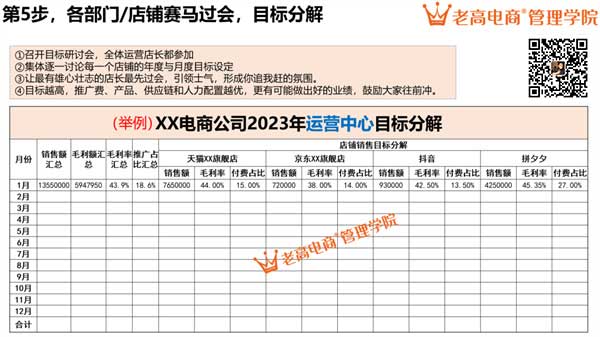
Step 6
Organizational upgrade and talent echelon construction
1. Re-optimize the organizational structure and business processes around performance goals.
2. Sort out job allocation and human resources planning.
3. Sort out the talent echelon, check for omissions and fill in the gaps, and survive the fittest.
4. Establish a job competency model and build a rapid talent training system.

Step 7
Annual Operation Improvement Plan (Operation Center)
1. Tmall and JD.com’s store growth plan
2. Growth plan of the waist camp
3. New channel/new store expansion plan
4. Traffic strategies and promotion cost budgets for each store
5. New product strategy, prosperous and stagnant goals, new product explosion process
6. Product layout, one-piece planning, price strategy
7. Year-round holiday activities plan and support
8. In-site and off-site content operation plan
9. Operation center organizational structure, job allocation and human resources plan
10. Talent echelon training plan...
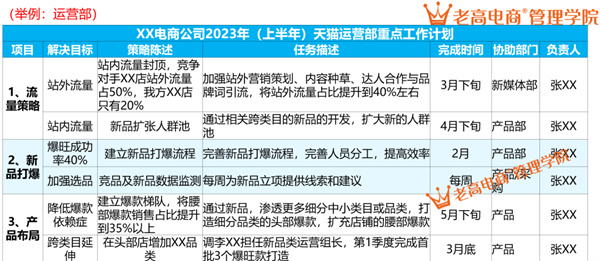
Step 8
Global Marketing Plan
1. New media grass planting and drainage, expert cooperation, budget and plan (New Media Department)
2. Taobao Live and Douyin Live Layout, Goals and Plans, Team Building (Live Broadcast Department)
3. Picture and text and short video content planning (Planning Department)
4. Short video, photography and video (visual department)
5. Private domain operation goals and plans (Private Domain Department)…
Step 9
Commodity and Supply Chain Support Program
1. Annual new product development plan (Commodity Department)
2. Annual procurement plan and supplier development management (Procurement department)
3. Annual warehousing and storage capacity planning, delivery order volume planning (Warehouse Department)
4. Annual quality control goals and plans (quality control department)
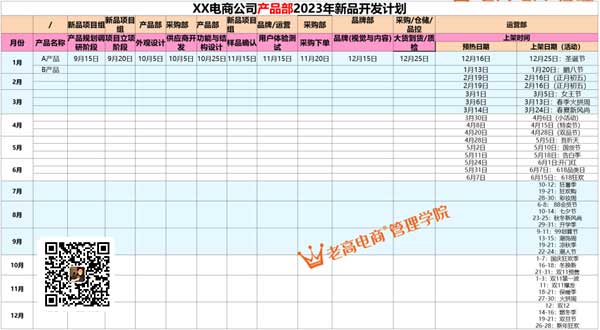
Step 10
Work ideas and plans of other functional departments
1. Human Resources Planning and Budget (District of Human Resources)
2. Company’s annual financial budget (financial department)
3. Customer Service Department’s Work Ideas and Team Building (Customer Service Department)
4. Design Department’s Work Ideas and Team Building (Design Department)
5. Brand visual improvement and public relations communication (Brand department)
Step 11
Regular review and monthly performance appraisal
1. Operations Department performance indicators: sales target achievement rate, gross profit margin, promotion expense ratio, etc.
2. Product Department indicators: development plan completion rate, explosive and stagnant ratio, inventory turnover rate, sold-out rate, etc.
3. Procurement Department indicators: supplier development and management, procurement pass rate, inventory turnover rate, out-of-stock rate, sold-out rate, etc.
4. Warehousing department indicators: delivery timeliness, error rate, inventory accuracy, 5S management, etc.
5. Customer service department indicators: average response time, inquiry conversion rate, service quality inspection score, etc.
5. Indicators of the Ministry of Personnel: recruitment plan completion rate, human efficiency, organizational structure, talent echelon construction, training system, corporate culture, etc.
6. Finance Department indicators: three financial statements, business analysis reports, tax risk control, tax planning, etc.













 EN
EN CN
CN
